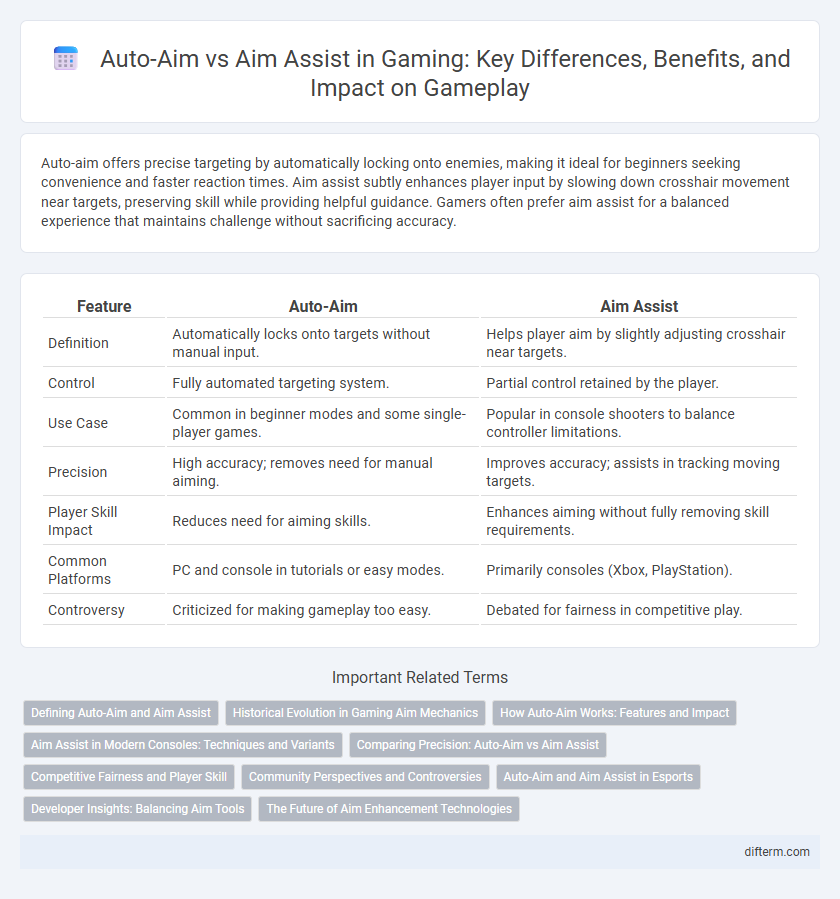Auto-aim offers precise targeting by automatically locking onto enemies, making it ideal for beginners seeking convenience and faster reaction times. Aim assist subtly enhances player input by slowing down crosshair movement near targets, preserving skill while providing helpful guidance. Gamers often prefer aim assist for a balanced experience that maintains challenge without sacrificing accuracy.
Table of Comparison
| Feature | Auto-Aim | Aim Assist |
|---|---|---|
| Definition | Automatically locks onto targets without manual input. | Helps player aim by slightly adjusting crosshair near targets. |
| Control | Fully automated targeting system. | Partial control retained by the player. |
| Use Case | Common in beginner modes and some single-player games. | Popular in console shooters to balance controller limitations. |
| Precision | High accuracy; removes need for manual aiming. | Improves accuracy; assists in tracking moving targets. |
| Player Skill Impact | Reduces need for aiming skills. | Enhances aiming without fully removing skill requirements. |
| Common Platforms | PC and console in tutorials or easy modes. | Primarily consoles (Xbox, PlayStation). |
| Controversy | Criticized for making gameplay too easy. | Debated for fairness in competitive play. |
Defining Auto-Aim and Aim Assist
Auto-aim is a gaming feature that automatically locks the player's crosshair onto a target, ensuring precise shooting without manual adjustment. Aim assist, however, provides subtle guidance by slightly slowing down the crosshair movement near an enemy, helping players maintain accuracy without taking full control. Both mechanics enhance aiming performance but differ in the level of player input required and control over targeting.
Historical Evolution in Gaming Aim Mechanics
Auto-aim emerged in early arcade and console shooters as a straightforward mechanism to assist players by automatically locking onto targets, providing accessibility and reducing player frustration. Aim assist evolved with the rise of console FPS games, offering subtle corrections to player input while maintaining skill-based aiming, enhancing gameplay fluidity. This historical progression reflects the gaming industry's shift from mechanical assistance toward balancing challenge and player control in aim mechanics.
How Auto-Aim Works: Features and Impact
Auto-aim functions by automatically locking the player's crosshair onto enemy targets within a defined range, enhancing precision and reducing the skill barrier in shooting games. Key features include target prioritization, dynamic tracking, and adjustable sensitivity settings that respond to player input and enemy movement. This system impacts gameplay balance by increasing accessibility for casual players while potentially diminishing the challenge and skill expression for competitive gamers.
Aim Assist in Modern Consoles: Techniques and Variants
Aim assist in modern consoles employs techniques such as magnetism, slowdown, and bullet magnet to enhance player targeting accuracy without fully automating the process, offering a balanced gameplay experience. Variants of aim assist adapt to game genres, including shooter-specific methods like sticky aim for locking onto moving targets and rotation-based assist for smoother camera movement. These sophisticated aim assist systems optimize player performance while preserving competitive integrity in popular franchises like Call of Duty, Fortnite, and Apex Legends.
Comparing Precision: Auto-Aim vs Aim Assist
Auto-aim offers pinpoint accuracy by automatically locking onto targets, eliminating the need for player input and ensuring consistent hits in fast-paced gaming scenarios. Aim assist provides a more subtle form of help by slightly slowing down cursor movement near targets, enhancing precision while still requiring player control. Comparing precision, auto-aim delivers flawless target acquisition, whereas aim assist balances precision with user skill, offering a more natural and engaging aiming experience.
Competitive Fairness and Player Skill
Auto-aim significantly reduces the emphasis on player skill by automatically locking onto targets, undermining competitive fairness in gaming. Aim assist offers subtle target correction, preserving player control and skill expression while making gameplay accessible across different skill levels. Balanced implementation of aim assist maintains a fair playing field and ensures competition rewards genuine player ability rather than automated assistance.
Community Perspectives and Controversies
Auto-aim and aim assist spark significant debate within gaming communities, with auto-aim often criticized for reducing player skill expression and aim assist praised for leveling the playing field, especially on controllers. Competitive players argue auto-aim undermines fair play by granting an unfair advantage, while casual gamers appreciate aim assist for improving accessibility. Controversies intensify during esports events where the presence or absence of these features can impact tournament integrity and viewer perception.
Auto-Aim and Aim Assist in Esports
Auto-aim and aim assist serve distinct roles in esports, where precision and player skill are paramount for competitive integrity. Auto-aim automates target locking, often giving players an unfair advantage, and is typically prohibited in professional gaming due to its impact on skill expression. Aim assist subtly enhances player control by smoothing aiming mechanics, balancing accessibility and competitive fairness in titles like Apex Legends and Call of Duty.
Developer Insights: Balancing Aim Tools
Developers emphasize the importance of balancing auto-aim and aim assist to maintain competitive fairness and player satisfaction in gaming environments. Auto-aim offers pixel-perfect targeting, often leading to gameplay that feels less skill-based, while aim assist subtly guides player input to enhance aiming precision without removing player agency. Effective tuning of these tools requires analyzing player feedback and in-game performance metrics to ensure an engaging yet accessible experience across diverse player skill levels.
The Future of Aim Enhancement Technologies
Auto-aim and aim assist technologies are evolving rapidly with advancements in AI and machine learning, offering increasingly precise targeting capabilities that adapt to player behavior in real time. Emerging systems leverage neural networks to predict enemy movements and optimize aim trajectories, reducing human error while preserving competitive balance. Future developments are expected to integrate biometric feedback and contextual awareness, further enhancing accuracy and immersion in gaming environments.
auto-aim vs aim assist Infographic

 difterm.com
difterm.com